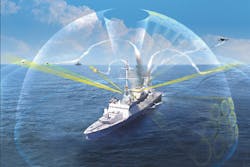Industry asked to develop microwave photonics components for RF and microwave applications like radar
ARLINGTON, Va. – U.S. military RF and microwave experts are reaching out to the microelectronics industry to develop lithium-niobate field-configurable modulator arrays (FCMAs) for point-to-point RF links, RF signal processing, radar, and RF spectrum management.
Officials of the U.S. Defense Advanced Research Projects Agency (DARPA) in Arlington, Va., issued a Small Business Innovation Research (SBIR) and Small Business Technology Transfer (STTR) opportunity announcement on Thursday (HR001120S0019-13) for the Field Controllable Modulator Array (FCMA) project.
Although microwave photonics represents an important technology for military applications, the military microwave photonic systems deployed to date repurpose commercial components for military functions.
The most recent developments in industrial telecommunications have been in specialized application-specific photonic integrated circuits (PICs). Today's military applications cannot use these devices, however, because application-specific PICs cannot be repurposed.
In addition, the volume of military systems is insufficient to support a dedicated PIC infrastructure at a bearable cost. Instead, the FCMA project seeks to solve this problem by developing FCMAs that can be purposed for military and commercial applications.
The FCMA concept is based on electro-optic modulators that can be programmed for different functions. Lithium niobate is considered to be mature, cost-effective, and performs well enough for military applications.
Performers will design, fabricate, and demonstrate an FCMA for electronic protection, signals intelligence, radar beamforming, and communications.
The FCMA must be able to operate from 1 MHz to 18 GHz, and use the nonlinear response of a Mach-Zehnder modulator to suppress a continuous-wave interference signal by 60 decibels to suppress an interference signal with 10 MHz instantaneous bandwidth by 40 decibels -- both while reducing the largest intermodulation distortion by 30 decibels.
The signals-intelligence configuration will improve the intrinsic third-order-limited spurious-free dynamic range of a Mach-Zehnder modulator by 10 decibels.
The radar-beamforming application will provide 360 degrees of RF phase shift that can be modulated at 100 kHz. The communications configuration, meanwhile, must support 10 gigabits per second of modulation on each of the in-phase and quadrature components of a lightwave.
Companies selected must demonstrate a complete FCMA design at a lithium-niobate foundry, which the company will identify. If successful, the company will package the FCMA chip in a sealed package. The final prototype will have a permanently attached fiber-optic input and output, with permanently attached RF and control connectors applied to the electrodes.
Companies should upload full proposals no later than 10 Aug. 2020 at www.dodsbirsttr.mil. Email technical questions to DARPA at [email protected], with BAA HR001120S0019-13 in the subject line.
More information is online at https://beta.sam.gov/opp/985131830e8f4e96b0efde5eccf82ee4/view.

John Keller | Editor-in-Chief
John Keller is the Editor-in-Chief, Military & Aerospace Electronics Magazine--provides extensive coverage and analysis of enabling electronics and optoelectronic technologies in military, space and commercial aviation applications. John has been a member of the Military & Aerospace Electronics staff since 1989 and chief editor since 1995.

